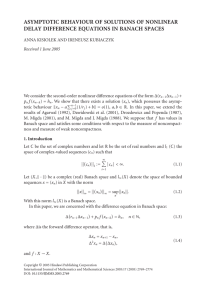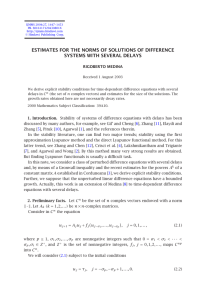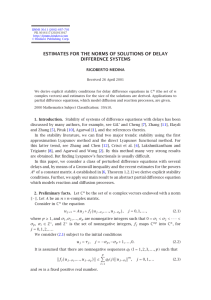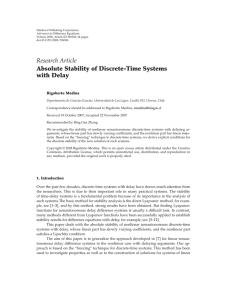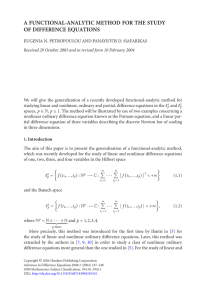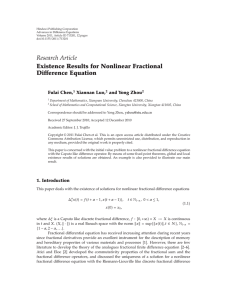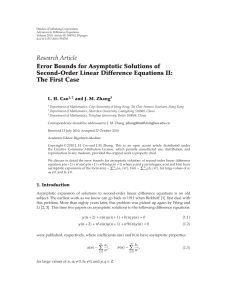Document 10677228
advertisement
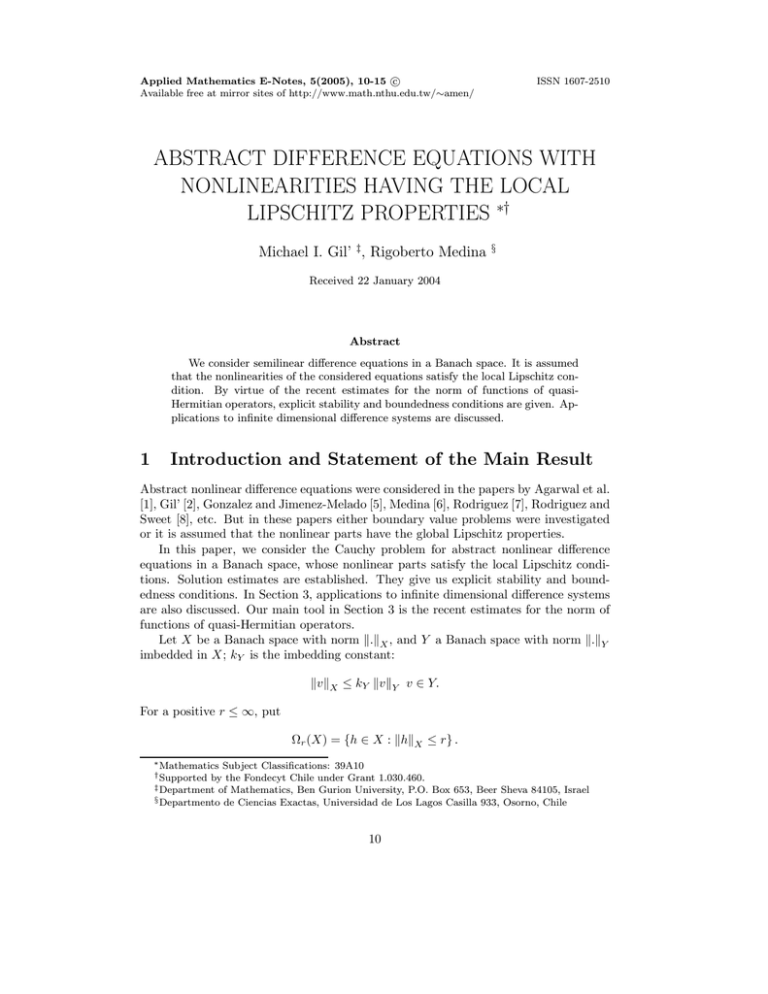
Applied Mathematics E-Notes, 5(2005), 10-15 c
Available free at mirror sites of http://www.math.nthu.edu.tw/∼amen/
ISSN 1607-2510
ABSTRACT DIFFERENCE EQUATIONS WITH
NONLINEARITIES HAVING THE LOCAL
LIPSCHITZ PROPERTIES ∗†
Michael I. Gil’ ‡, Rigoberto Medina
§
Received 22 January 2004
Abstract
We consider semilinear difference equations in a Banach space. It is assumed
that the nonlinearities of the considered equations satisfy the local Lipschitz condition. By virtue of the recent estimates for the norm of functions of quasiHermitian operators, explicit stability and boundedness conditions are given. Applications to infinite dimensional difference systems are discussed.
1
Introduction and Statement of the Main Result
Abstract nonlinear difference equations were considered in the papers by Agarwal et al.
[1], Gil’ [2], Gonzalez and Jimenez-Melado [5], Medina [6], Rodriguez [7], Rodriguez and
Sweet [8], etc. But in these papers either boundary value problems were investigated
or it is assumed that the nonlinear parts have the global Lipschitz properties.
In this paper, we consider the Cauchy problem for abstract nonlinear difference
equations in a Banach space, whose nonlinear parts satisfy the local Lipschitz conditions. Solution estimates are established. They give us explicit stability and boundedness conditions. In Section 3, applications to infinite dimensional difference systems
are also discussed. Our main tool in Section 3 is the recent estimates for the norm of
functions of quasi-Hermitian operators.
Let X be a Banach space with norm . X , and Y a Banach space with norm . Y
imbedded in X; kY is the imbedding constant:
v
X
≤ kY v
Y
v ∈ Y.
For a positive r ≤ ∞, put
Ωr (X) = {h ∈ X : h
∗ Mathematics
X
≤ r} .
Subject Classifications: 39A10
by the Fondecyt Chile under Grant 1.030.460.
‡ Department of Mathematics, Ben Gurion University, P.O. Box 653, Beer Sheva 84105, Israel
§ Departmento de Ciencias Exactas, Universidad de Los Lagos Casilla 933, Osorno, Chile
† Supported
10
M. Gil’ and R. Medina
11
Consider in X the nonlinear difference equation
xk+1 = Axk + Fk (xk ) , k = 0, 1, 2, ...,
(1)
where A is a bounded linear operator in Y and Fk : Ωr (X) ∩ Y → Y is continuous for
each k ≥ 0. In addition, there are nonnegative constants q and ξ such that
Fk (h)
Y
≤q h
+ ξ, h ∈ Ωr (X); k = 0, 1, 2, ... .
Y
THEOREM 1. Suppose the condition (2) holds. Suppose further that
M := sup Aj Y < ∞,
(2)
(3)
j
θ :=
∞
[
j
A < q −1
Y
(4)
j=0
and
kY
M v Y + θξ
< r, v ∈ Y.
1 − qθ
(5)
Then any solution {xk }∞
k=0 of (1) with the initial condition x0 = v, satisfies the relations
xk
Y
≤
M v Y + θξ
, k = 1, 2, ... .
1 − qθ
(6)
The proof of this theorem is presented in the next section.
2
Proof of the Theorem 1
We begin with a lemma.
LEMMA 1. Suppose condition (2) holds with r = ∞. Then, under conditions
∞
(3) and (4), any solution {xk }k=0 of (1), with the initial condition x0 = v , satisfies
inequality (6).
PROOF. It is well known that the general solution of (1) is given by
xk = Ak x0 +
k−1
[
Ak−j−1 Fj (xj ) , k = 1, 2, ... .
j=0
Hence,
xk
Y
≤ M x0
Y
+
k−1
[
j=0
k−j−1
A
Fj (xj )Y .
12
Abstract Difference Equations
Now, condition (2) implies
xk
Y
≤ M x0
Y
+
k−1
[
j=0
Hence, it follows that
sup xk
k
Y
≤ M v
Y
≤ M v
Y
k−j−1 A
q xj
Y
+ q sup xk
Y
k
k−1
[
j=0
+ q sup xk
+ξ .
k−1
[
k−j−1 A
+ξ
Ak−j−1 Y
Y
j=0
θ + ξθ.
Y
k
Y
Thus, condition (4) yields
sup xk
k
Y
≤ (1 − qθ)−1 [M v
Y
+ ξθ].
Hence the required result follows.
Proof of Theorem 1. If r = ∞, then the required result follows from Lemma 1.
It remains to prove the statement in the case r < ∞. Define the functions
Fk (x) , x X ≤ r
Fhk (x) =
0, x X > r.
for k = 0, 1, 2, . . . . Since
h
Fk (v) ≤ q v
Y
Y
+ ξ, v ∈ Y ; k = 0, 1, 2, ...,
then the sequence {h
xk }∞
k=0 defined by
x
h0 = x0 ; x
hk+1 = Ah
xk + Fhk (xk ) ; k = 1, 2, ...,
satisfies the inequality
x
hk
X
≤ kY (M x0
Y
−1
+ θξ) (1 − qθ)
< r,
provided that (5) holds. But Fk (x) and Fhk (x) coincide on the ball Ωr (X) . From
this we infer that xk = x
hk for k = 0, 1, 2, ... and therefore (6) is satisfied, concluding
the proof.
3
Infinite Dimensional Systems of Difference Equations
As usual, l2 is the Hilbert space of number sequences equipped with the norm
h
l2
=
%
∞
[
k=1
|hk |
2
& 12
, h = (hk ) ∈ l2
M. Gil’ and R. Medina
13
and c0 is the Banach space of number sequences equipped with the norm
h
c0
= sup |hk | , h = (hk ) ∈ c0 .
k
Everywhere in this section
A = (ajk )∞
j,k=1
is an infinite matrix with real entries. It is assumed that
∞
∞
1
1 [ [
|ajk − akj |2 ] 2 < ∞.
J(A) = √ [
2 j=1 k=1,k=j
(7)
In this section, we take Y = l2 and X = c0 and kY = 1. So, (2) takes the form
Fk (h)
l2
≤q h
l2
+ ξ (h ∈ Ωr (c0 )) .
(8)
Assume that the spectral radius ρ(A) of A satisfies the inequality
ρ(A) < 1.
(9)
Set
ψ (A) := sup
m
m
[
m!ρm−k (A) J k (A)
3
k=0
(m − k)! (k!) 2
and
γ(A) :=
√
J 2 (A)
2
.
exp
1 − ρ(A)
(1 − ρ(A))2
Below we check that under (9), ψ(A) < ∞.
THEOREM 2. Under conditions (7)-(9), let
qγ (A) < 1
and
ψ (A) v l2 + γ (A) ξ
< r, v ∈ l2 .
1 − qγ (A)
Then any solution {xk }∞
k=0 of (1), with the initial condition x0 = v , satisfies the
relations
xk
l2
≤ (ψ (A) v
l2
+ γ (A) ξ) (1 − qγ (A))
−1
, k = 1, 2, ... .
PROOF. We need the following result: under condition (7), the inequality
Am
l2
≤
m
[
m!ρm−k (A) g k (A)
I
3
k=0
(m − k)! (k!) 2
, m = 1, 2, ...
14
Abstract Difference Equations
is valid, where
%
gI (A) := 2N 2 (AI ) − 2
∞
[
k=1
2
| Im (λk (A))|
& 12
≤ J (A) ,
∗
AI = A−A
2i , N (.) is the Hilbert-Schmidt norm and λk (A) are the eigenvalues of A
(see [4, Theorem 7.10.1]). Thus, M ≤ ψ(A) and
θl =
But
j
∞
∞ [
[
[
j
j!ρj−k (A) gIk (A)
A 2 ≤
.
3
l
(j − k)! (k!) 2
j=0
j=0 k=0
j
∞ [
[
j!ρj−k (A) g k (A)
I
3
j=0 k=0
=
(j − k)! (k!) 2
∞
∞
[
g k (A) [ j!ρj−k (A)
I
1
j=0
=
(k!) 2
∞
[
g k (A)
I
j=0
(k!)
1
2
j=k
(j − k)!k!
(1 − ρ (A))−k−1 .
Hence it follows that ψ(A) < ∞. By the Schwarz inequality we get
∞
[
g k (A)
I
1
j=0
(k!) 2
−k−1
(1 − ρ (A))
≤
k
l
√
−1
−2
2 (1 − ρ (A)) exp gI2 (A) (1 − ρ (A))
.
Thus, θ ≤ γ (A). Now by Theorem 1, we conclude that Theorem 2 is valid.
REMARK. Estimates for ρ (A) can be found in [3].
Let us give an example of A = (ajm ) and Fk that satisfy conditions (7)-(9). Take
ajm =
1
, j ≤ m,
m(1 + j)
and
ajm = 0, j > m.
Then
ρ(A) = sup |ajj | = sup
j
j≥1
1
1
=
j(1 + j)
2
cf. [3]. Moreover,
J 2 (A) =
∞ [
∞
[
j=1 k=j+1
1
< ∞.
k2 (1 + j)2
So conditions (7) and (9) are satisfied. Furthermore, take
Fk (v) = (fkj (v))∞
j=1
M. Gil’ and R. Medina
15
with
fkj (v) = djk
∞
[
m=1
p
vm
, k, j = 1, 2, ...; v = (vk ) ∈ l2 , p > 2,
where djk are real constants with
∞
[
|djk |2 ]1/2 < ∞.
q1 := sup[
k
j=1
Then
Fk (v)
2
l2
≤
∞
[
j=1
2
|djk | [
∞
[
m=1
p 2
|vm | ] ≤
q12 [rp−2
∞
[
m=1
|vm |2 ]2 , v
c0
≤ r.
So condition (8) also holds with q = q0 rp−2 , ξ = 0.
References
[1] R. P. Agarwal, H. B. Thompson and C. C. Tisdell, Difference equations in Banach
spaces, Advances in difference equations IV, Comput. Math. Appl., 45(2003), 1437—
1444.
[2] M. I. Gil’, Periodic solutions of abstract difference equations, Applied Mathematics
E-Notes, 1(2001), 18—23.
[3] M. I. Gil’, Invertibility and spectrum of Hille-Tamarkin matrices, Math. Nachr.
244(2002), 78—88.
[4] M. I. Gil’, Operator Functions and Localization of Spectra, Lectures Notes In Mathematics, Vol. 1830, Springer Verlag, Berlin, 2003.
[5] C. Gonzalez and A. Jimenez-Melado, An application of Krasnoselskii fixed point
theorem to the asymptotic behavior of solutions of difference equations in Banach
spaces, J. Math. Anal. Appl., 247(2000), 290—299.
[6] R. Medina, Solvability of discrete Volterra equations in weighted spaces, Dynamic
Systems Appl., 5(1996), 407—422.
[7] J. Rodriguez, On nonlinear discrete boundary value problems, J. Math. Anal. Appl.,
114(2)(1986), 398—408.
[8] J. Rodriguez and D. Sweet, Nonlinear boundary value problems on sequence spaces,
J. Difference Eq. Appl., 8(2)(2002), 153—162.

